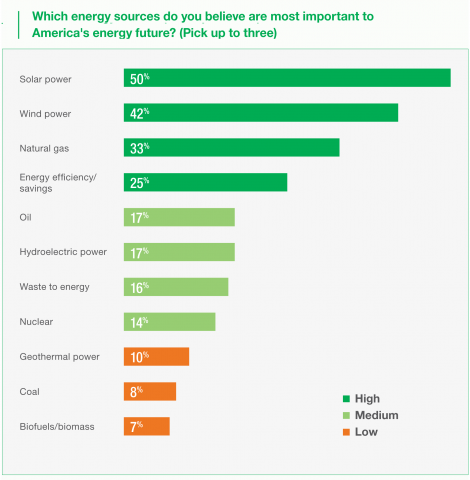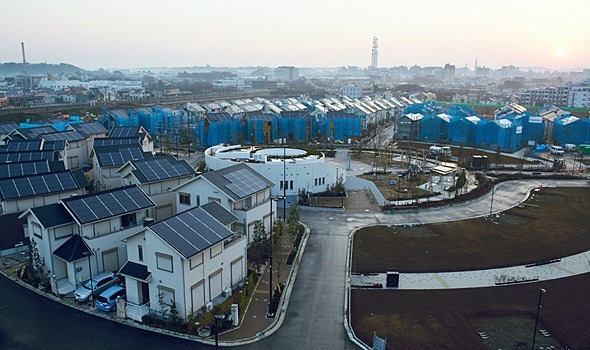 Last week, we published the tale of two public opinion polls, one from Gallup and one from the Nuclear Energy Institute, that asked the same question but came up with radically different numbers.
Last week, we published the tale of two public opinion polls, one from Gallup and one from the Nuclear Energy Institute, that asked the same question but came up with radically different numbers.
Another new poll provides additional proof that one of those polls cited last week–the NEI poll–is the one that is way off base.
This new poll, conducted by Clean Edge and SolarCity, is consistent with the findings of just about every poll published in recent years except NEI’s: Americans love renewables and really don’t like nuclear power and coal very much.
Indeed, as the poll sponsors stated, support for renewables transcends every demographic breakdown: “In a nation divided on a range of issues, it appears overwhelmingly united in its support of renewables, with nearly nine in ten Americans (87%) saying renewable energy is important to the country’s future.”
When asked to pick from a list of electricity generation sources the three most important to our energy future, solar and wind led the pack, with 50% and 42% respectively. Nuclear came in near the bottom at 14%, with coal scraping the barrel at 8%. Somewhat surprisingly, geothermal was also unpopular (10%) and biofuels/biomass was at the very bottom with 7%. It may be that Americans just don’t see either of those as major contributors to our electricity supply, rather than a reflection of their potential clean energy value. Or perhaps those industries need to communicate their value better (of course, in the case of biomass, much of that is dirty energy itself).
Digging deeper into the numbers, the sponsors determined that “solar power was the top choice among all major demographic groups including Republicans, Democrats, Independents, conservatives, liberals, city and rural dwellers, youth, and the elderly.
And digging still deeper revealed some very bad news for the nuclear power industry (and the fracking industry as well): young people have turned solidly against the technology:
“While solar was supported across all age groups, both natural gas and nuclear declined significantly with younger respondents. Natural gas was supported by those over 70 (43%) but dropped down significantly to 27% for those aged 18-24. Nuclear was supported by those over 70 (24%) but dropped precipitously to 8% for ages 25-34 and to just 1% for ages 18-24.”
The poll found that homeowners support federal tax incentives for renewable energy (74%) and 61% “oppose any utility effort to impose a rooftop solar fee for panels that are connected to the grid, while just 24% support such fees. Such opposition is stronger among rural dwellers and Republicans than city residents and Democrats.”

All of that is giving utility executives the blues, and at least partially explains why Utility Dive’s annual survey of utility executives indicates that opposition to rooftop solar–especially the net metering and other pro-solar policies the public supports so strongly–is number one on their to-do list this year.
Meanwhile, the Rocky Mountain Institute has released another major report that will give those same executives indigestion–the seemingly inevitable march to widespread grid defection that low-cost battery back-up systems to rooftop solar will enable.
Tesla Motors’ Elon Musk, who is also a key player in Solar City, is expected to accelerate that indigestion with a major announcement later this month: the first mass-scale, low-cost home battery system for rooftop solar.
So what we have in the middle of this decade, as renewable energy prices continue to fall and the old nuclear and coal technologies continue to fail, is a utility industry that appears dead-set on declaring war with its own customers (for an idea of just how vast the chasm between renewables and coal has become, consider this: from 2008-2012, coal lost nearly 50,000 jobs, during that same period, solar and wind gained 79,000 jobs. Nuclear stayed static, but that’s primarily because the wave of reactor closings didn’t begin until 2013) .
As John Farrell at ILSR explains in an excellent piece titled Why Utilities Are Hating on Their Solar-Producing Customers, “In a competitive business it would seem mad to fight your own customers, but most utilities aren’t in competition (even in states where there is competition in selling electricity to ultimate customers, the ownership of the distribution grid remains a monopoly).”
Farrell points out an essential truth: “Most utilities see a solar array on a customer rooftop the same as they see an energy efficient refrigerator. It means the customer buys less electricity.” Add to that the possibility of grid defection entirely as a result of low-cost battery systems, and you have utilities like Exelon and Entergy–with massive investment in now-uneconomic nuclear reactors–looking ahead and seeing a future with not only “less electricity” sales, but hundreds of thousands if not millions of former customers with zero electricity sales. No wonder the utilities are going bonkers and seeking bailouts across the country.
They’re running scared. Even more scared than they have to be, because they just don’t understand the future electricity system based on distributed generation. And it doesn’t help that both federal and state policies are set up to bolster the electricity system of the past, not the one that is moving inexorably–and faster and faster–to the future.
Writes Farrell,
Consider the difference between a 20th century and 21st century electricity system. In the 20th century, power was generated in large-scale power plants at a distance from population centers, sent by large transmission lines to cities, and managed in a centralized, top-down fashion by a monopoly electric company. There was no viable alternative to this model.
Today, we can generate power on rooftops or farm fields, manage it in real-time with smart thermostats or appliances, and control it remotely with smartphone apps and automation software. In this environment, do we need a traditional, top-down electric utility?…..
Imagine how typewriter companies felt upon the introduction of personal computers, how landline phone companies felt a decade ago. Electric utility executives are in a similar position, locked in an outdated paradigm and without a strategy for reaching a different future.
The key difference is that electric companies wield enormous market and political power over their system. They have publicly-sanctioned monopolies, and huge streams of monopoly-shielded revenue they use to hire lobbyists and lawyers to dominate state legislatures and utility commissions.”
Farrell’s conclusion is that the utility monopolies must be smashed, much as AT&T had to be broken up to both spur competition in the telecommunications field and to break up its political power as well.
That may well be. And that might even be better for the utilities in the long run than simply losing their customers entirely, and for good. It certainly would be better for the grid itself, which will never (and should never) go completely away. And, after all, no one is shedding any tears for the old days of Ma Bell, an era in which it would have been impossible to introduce smartphones, texting, and more; possibly wi-fi and the internet itself.
It seems highly unlikely that, twenty years from now, anyone will be shedding any tears for the demise of Exelon and Entergy either.
Former Indiana Senator Evan Bayh, now a pitchman for Exelon’s astroturf group Nuclear Matters, told the Houston Chronicle a few days ago, “When I flip the light switch, I don’t give a lot of thought to where the power comes from.” He was trying, in a rather flailing manner, to argue in favor of keeping nuclear reactors open, and while he may be right that some Americans feel that way, the argument falls flat when the polls consistently show that Americans do care about where their power comes from. And, not only that, they care a lot about how much their power costs: rooftop solar now provides power as cheap–or even cheaper–than the old nuclear and coal standbys, and with a lot more personal control and soon without a need for a utility bill at all.
With a reality like that, it’s not surprising that many utilities’ number one priority this year is attempting to stop rooftop solar (and, not incidentally, keep their uneconomic reactors and coal plants operating just a bit longer). But you can’t stop a tsunami, and you can’t prevent tomorrow’s sunrise either. As much as the utilities might like to.
The utilities’ war on solar may result in a few but short-lived victories for them. But the war will lose in the end for a pretty simple reason: Americans already have decided the outcome. Whether they decide to win the war in the voting booth or by simply moving off the grid or, more likely, a combination of the two (Americans also want the next President to take serious action on climate), Americans have chosen renewables.
Michael Mariotte
April 7, 2015
Permalink: https://www.nirs.org/2015/04/07/the-utilities-war-on-solar-wont-work/
Your contributions make publication of GreenWorld possible. If you value GreenWorld, please make a tax-deductible donation here and ensure our continued publication. We gratefully appreciate every donation of any size.
Comments are welcome on all GreenWorld posts! Say your piece. Start a discussion. Don’t be shy; this blog is for you.
If you’d like to receive GreenWorld via e-mail, send your name and e-mail address to nirs@nirs.org and we’ll send you an invitation. Note that the invitation will come from a GreenWorld@wordpress.com address and not a nirs.org address, so watch for it. Or just put your e-mail address into the box in the right-hand column.
If you like GreenWorld, help us reach more people. Just use the icons below to “like” our posts and to share them on the various social networking sites you use. And if you don’t like GreenWorld, please let us know that too. Send an e-mail with your comments/complaints/compliments to nirs@nirs.org. Thank you!
GreenWorld is crossposted on tumblr at https://www.tumblr.com/blog/nirsnet



